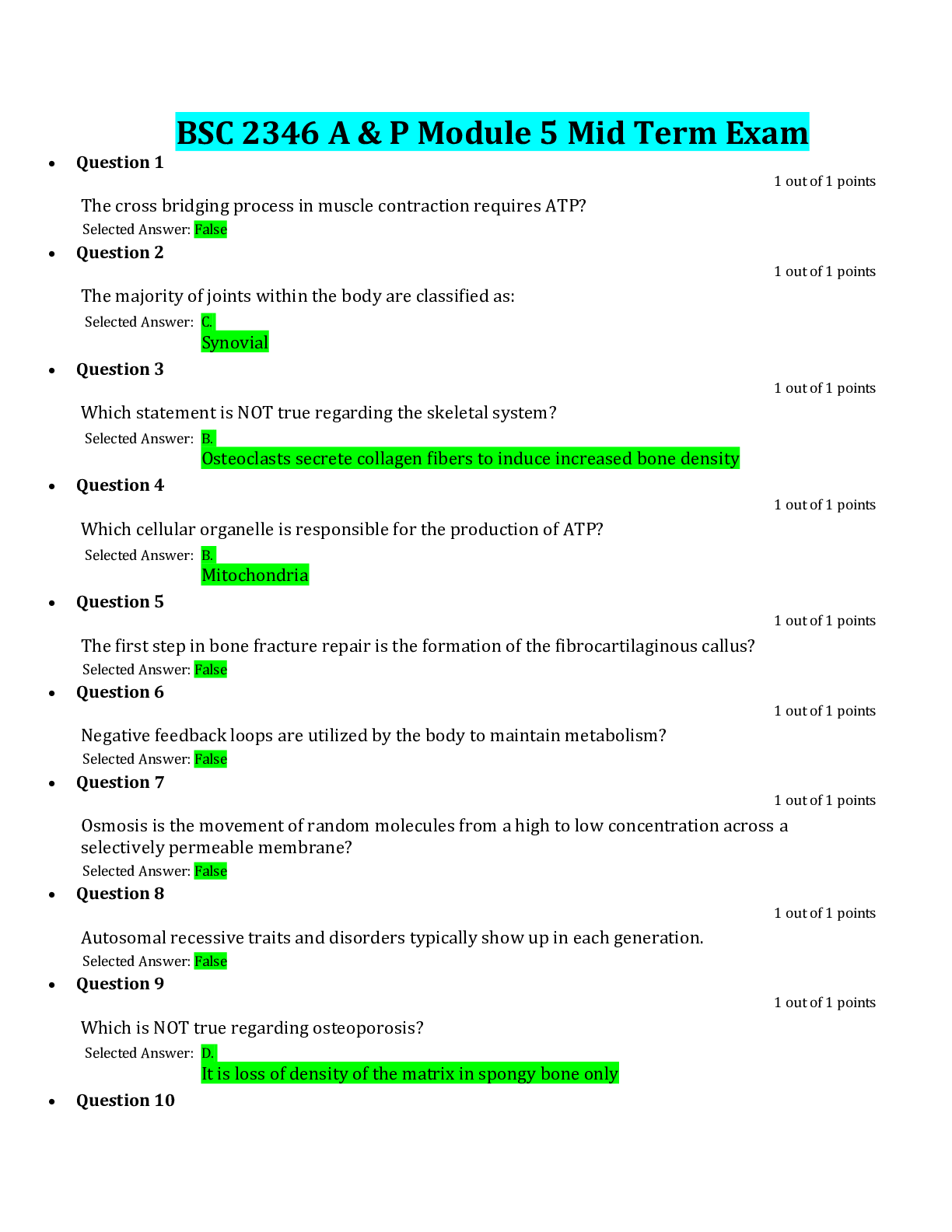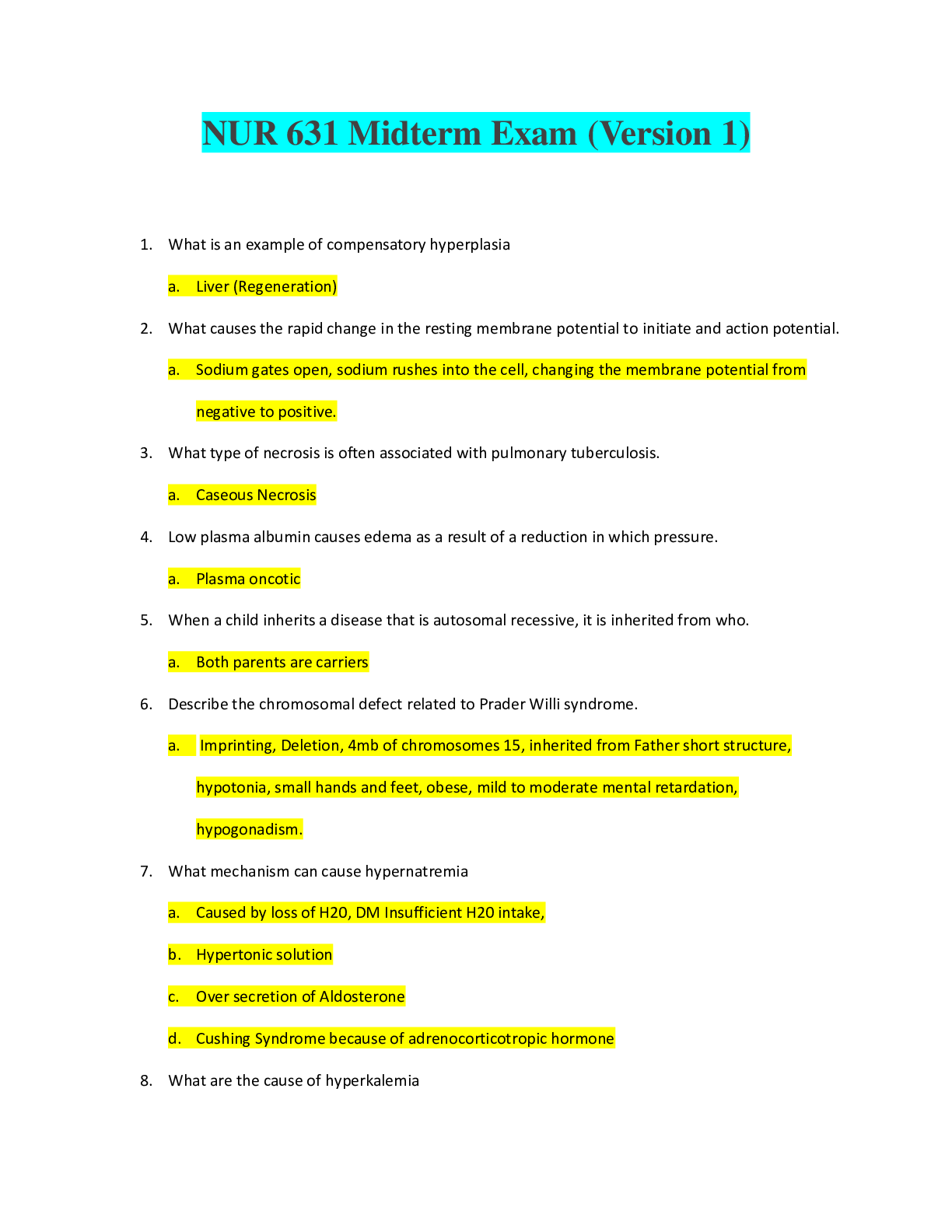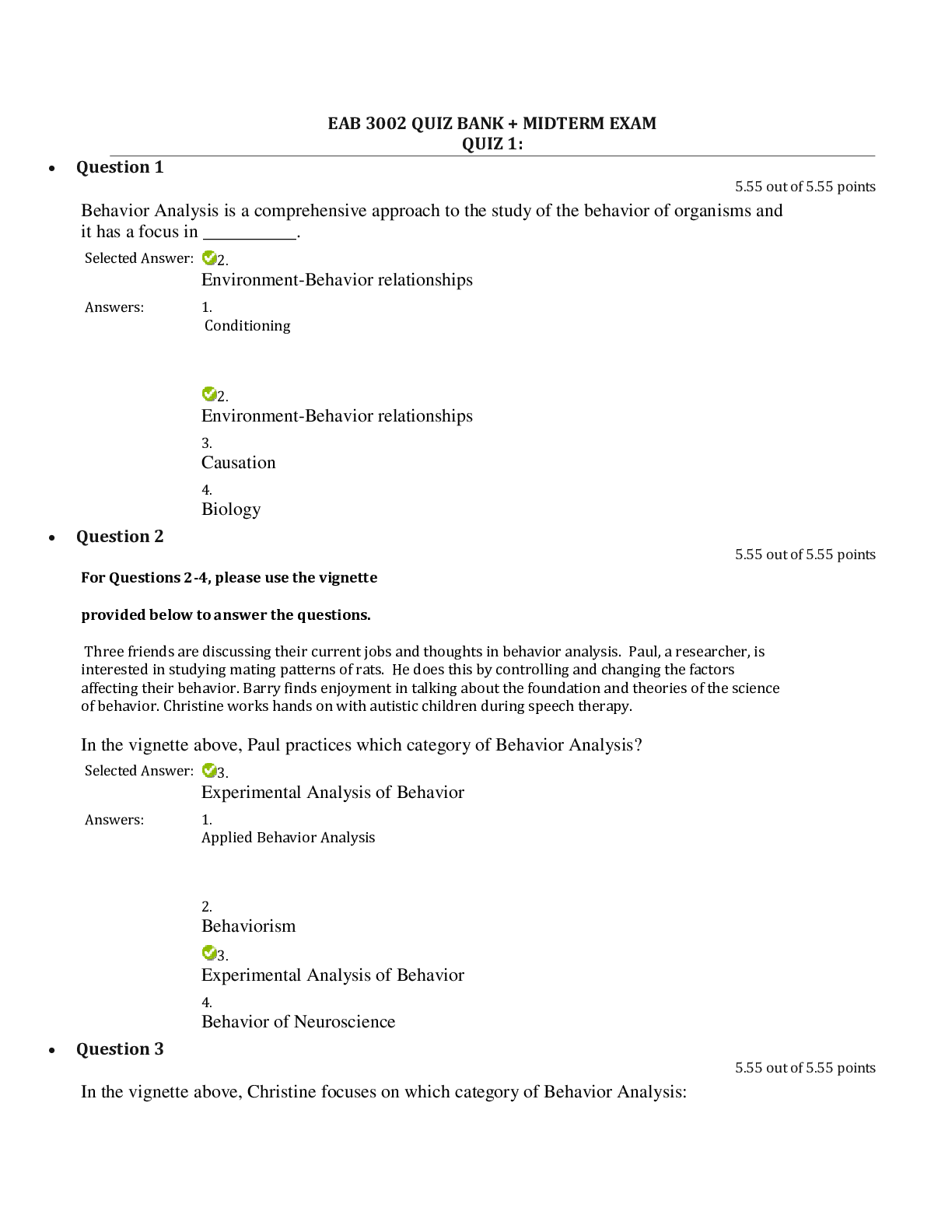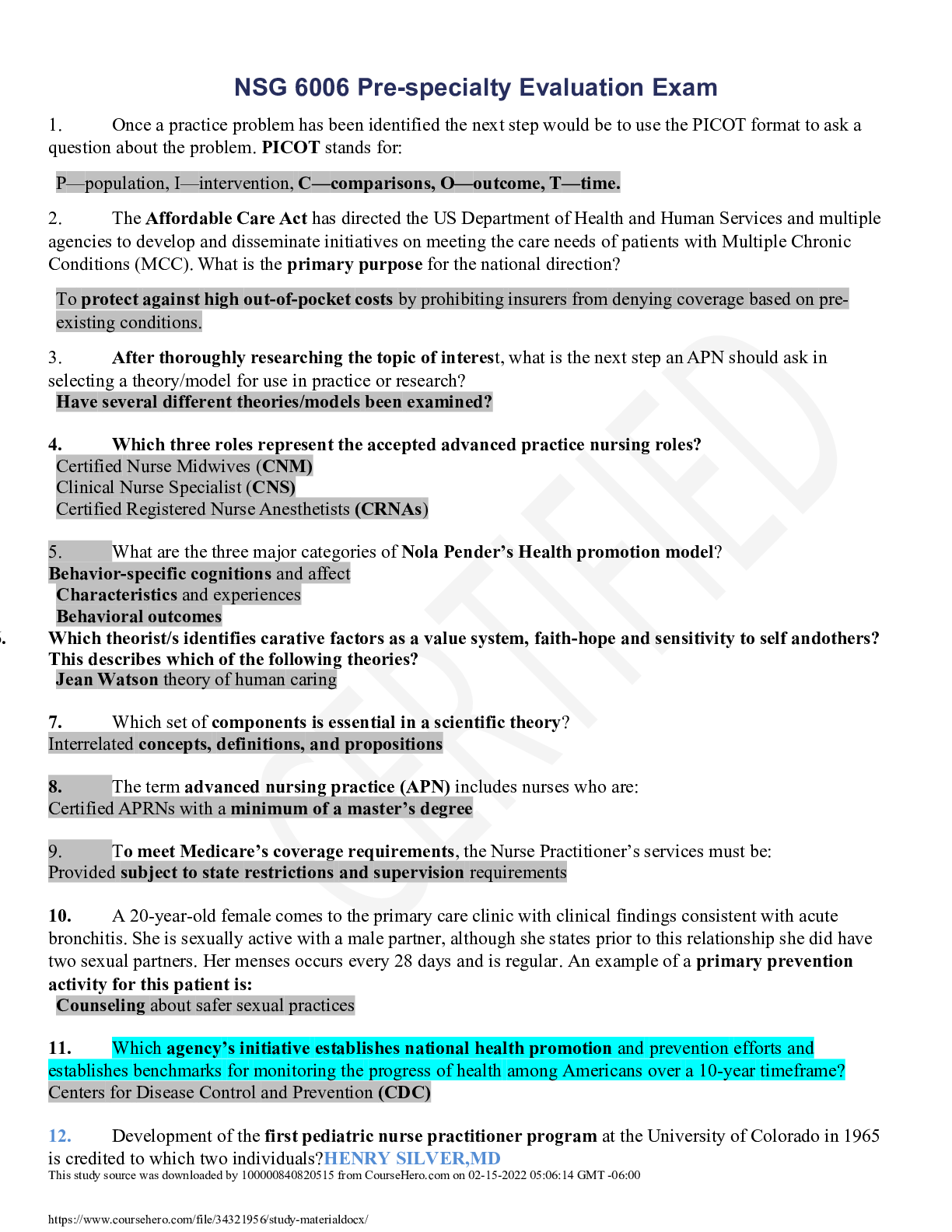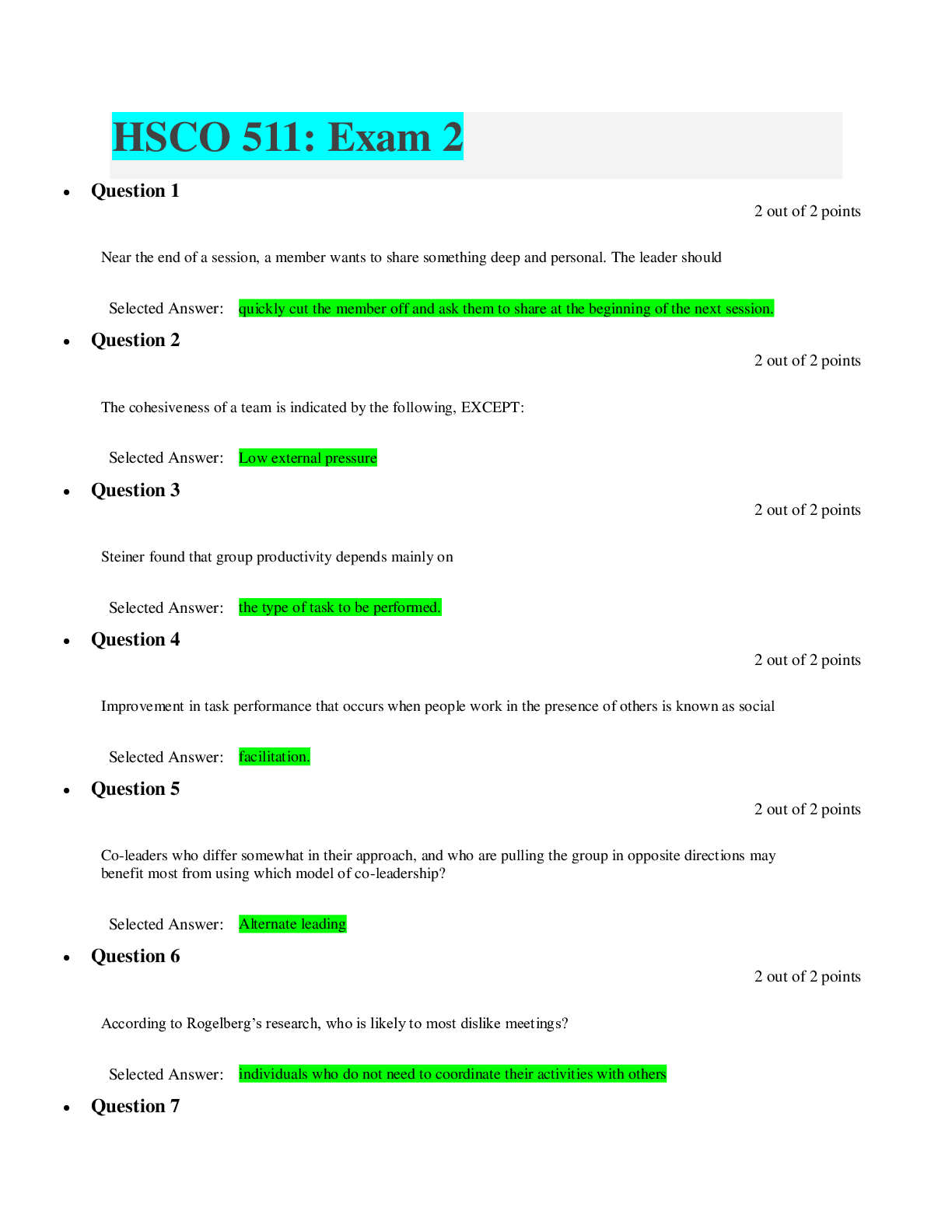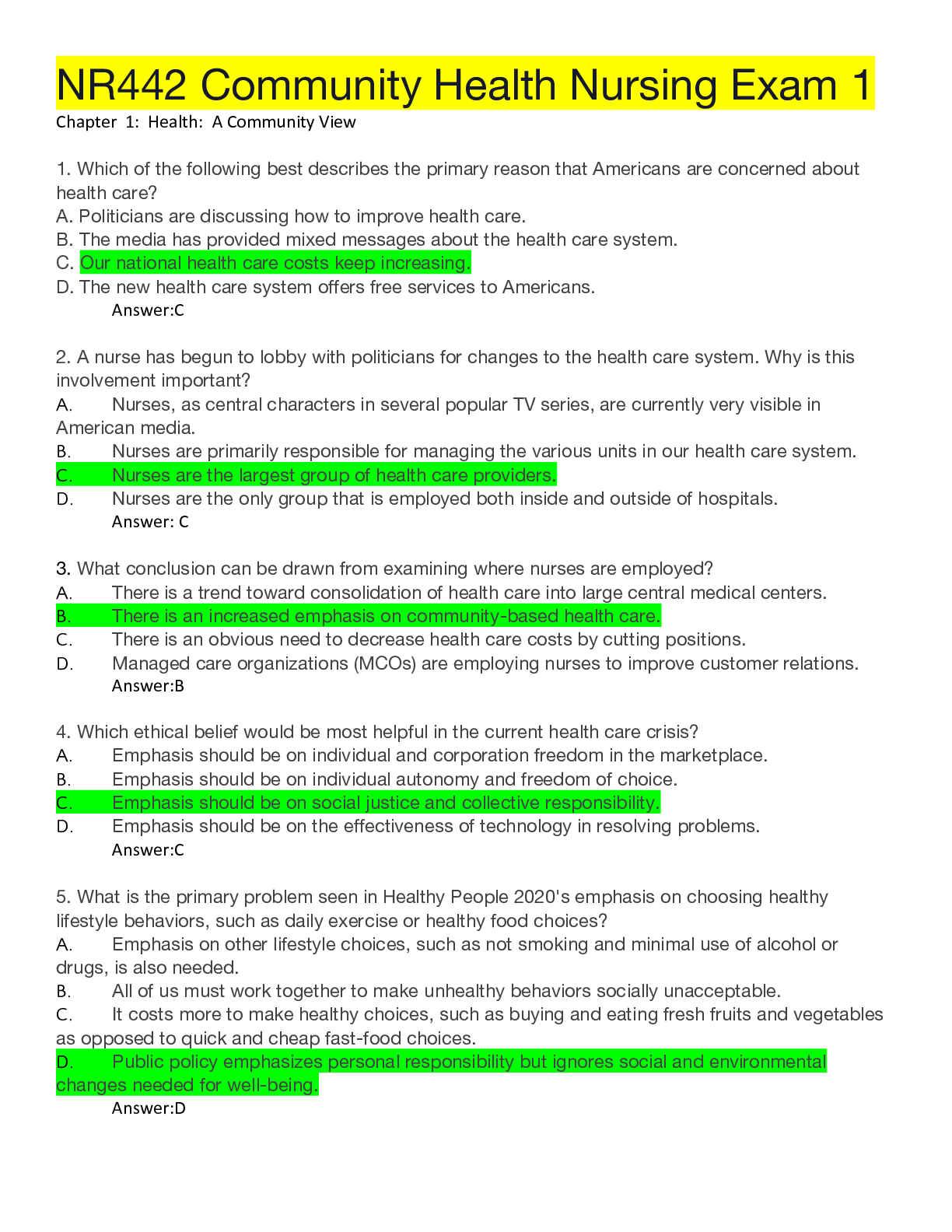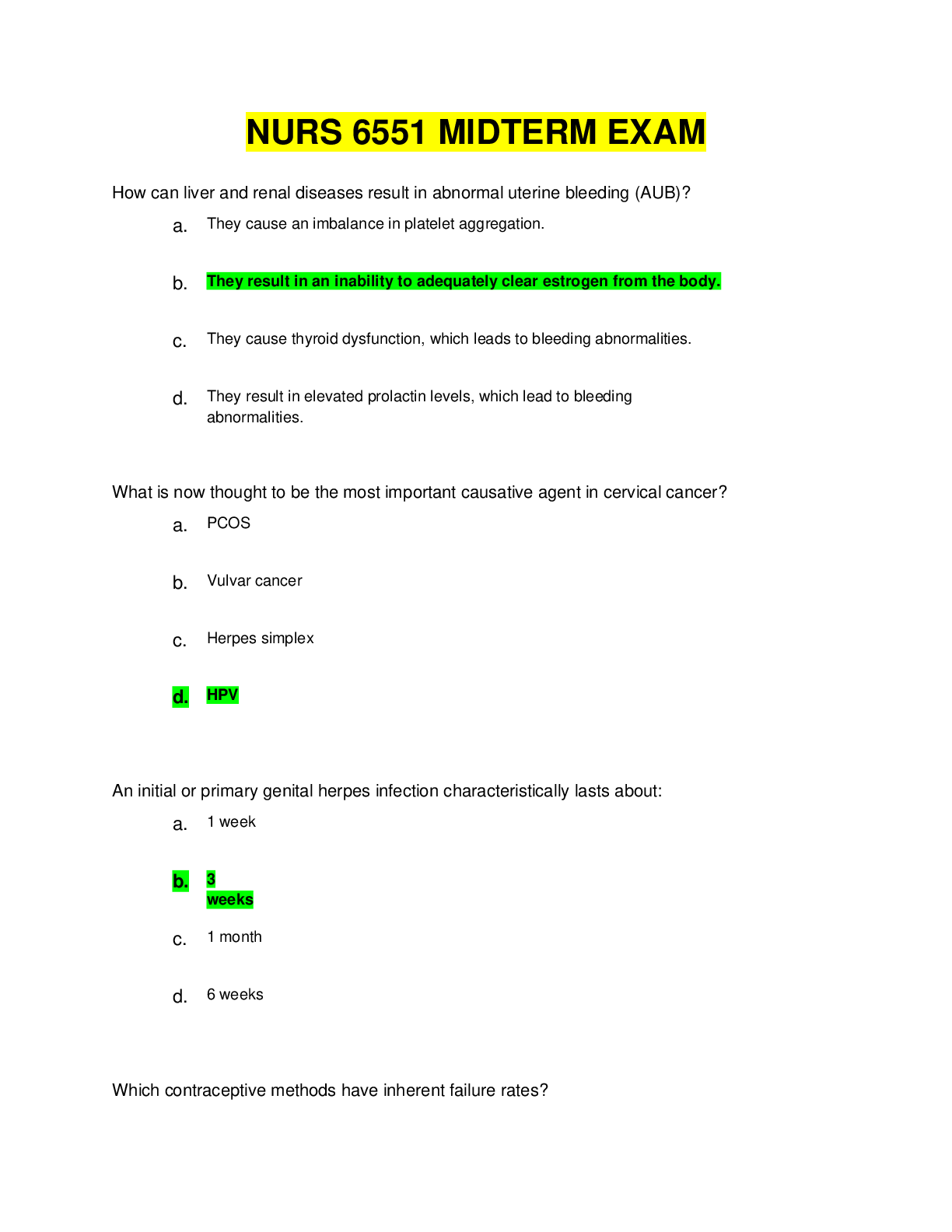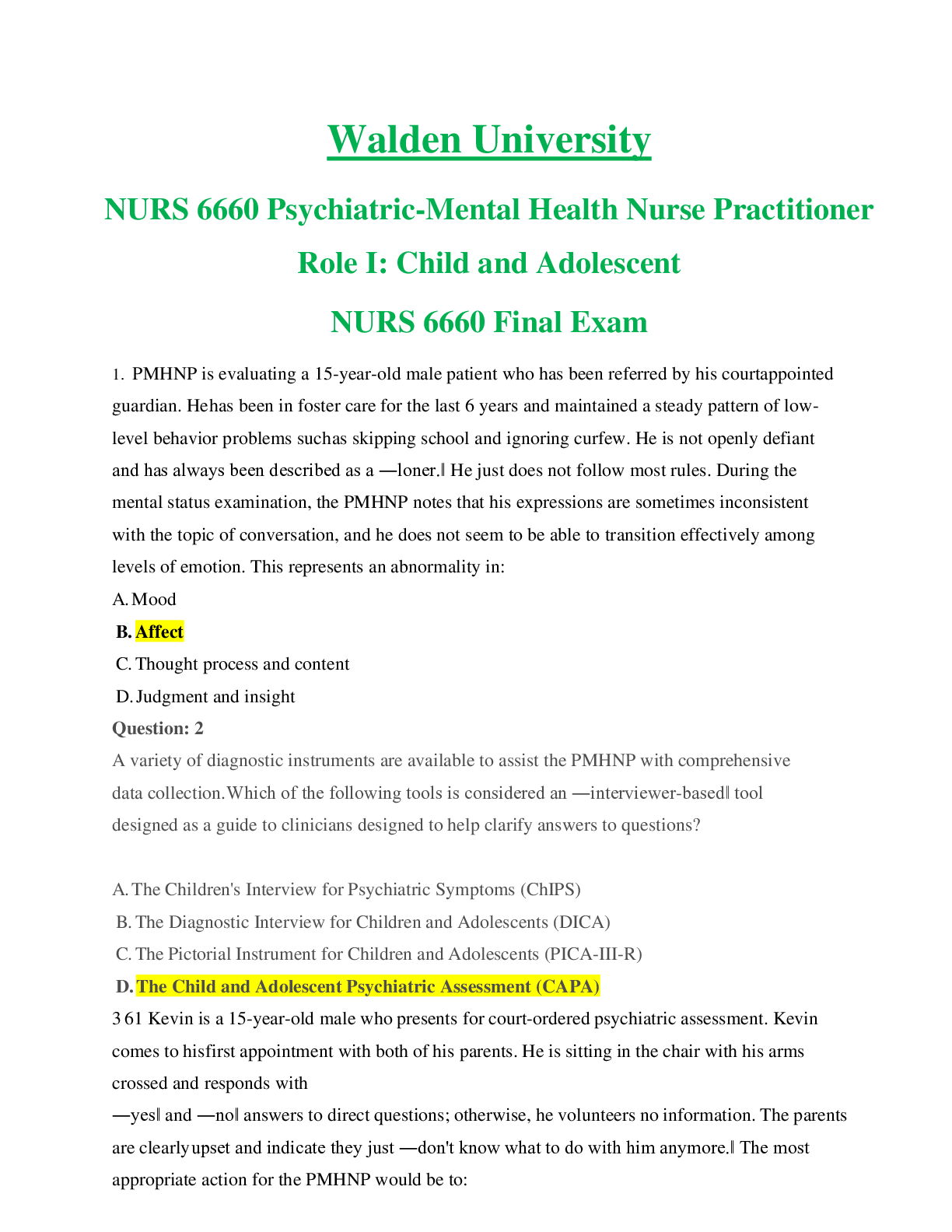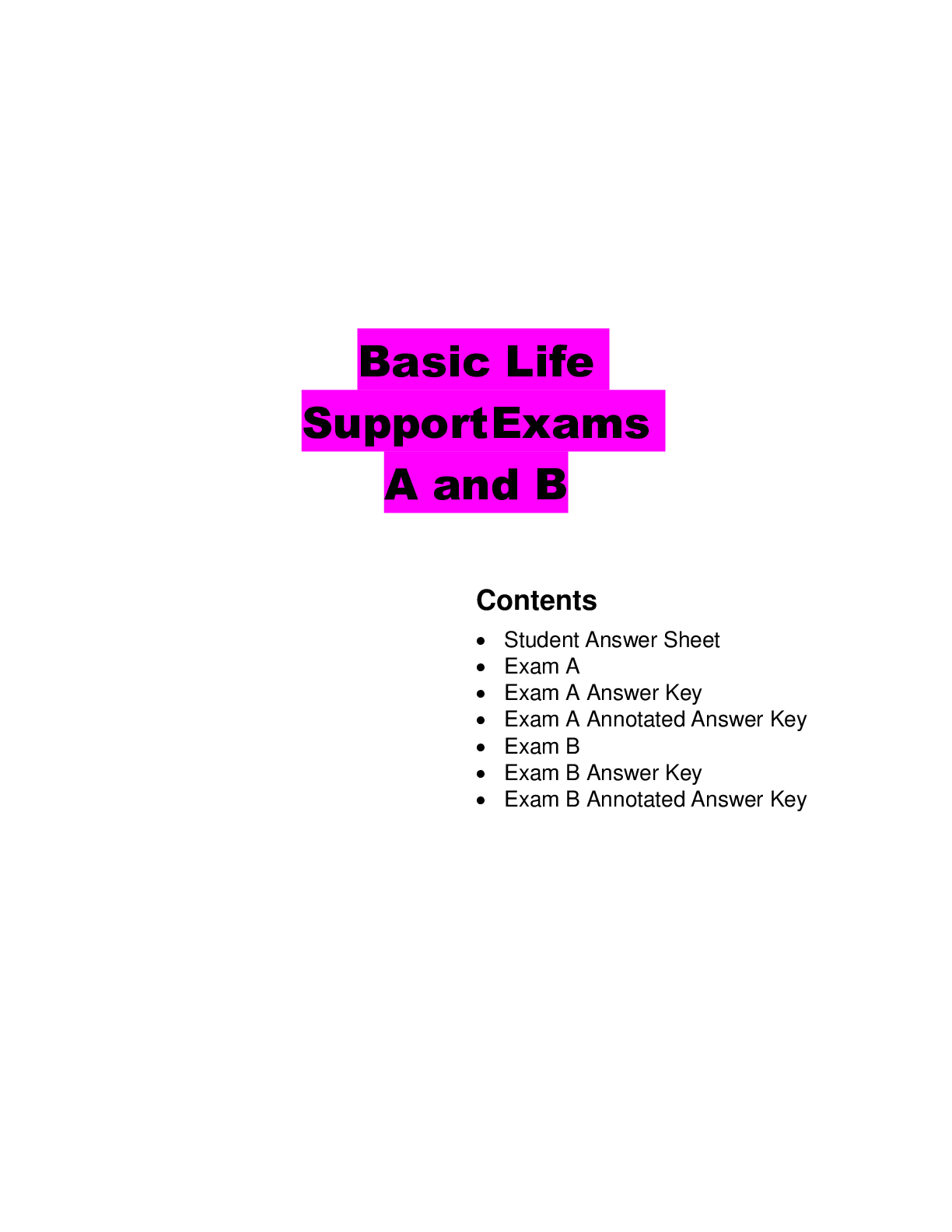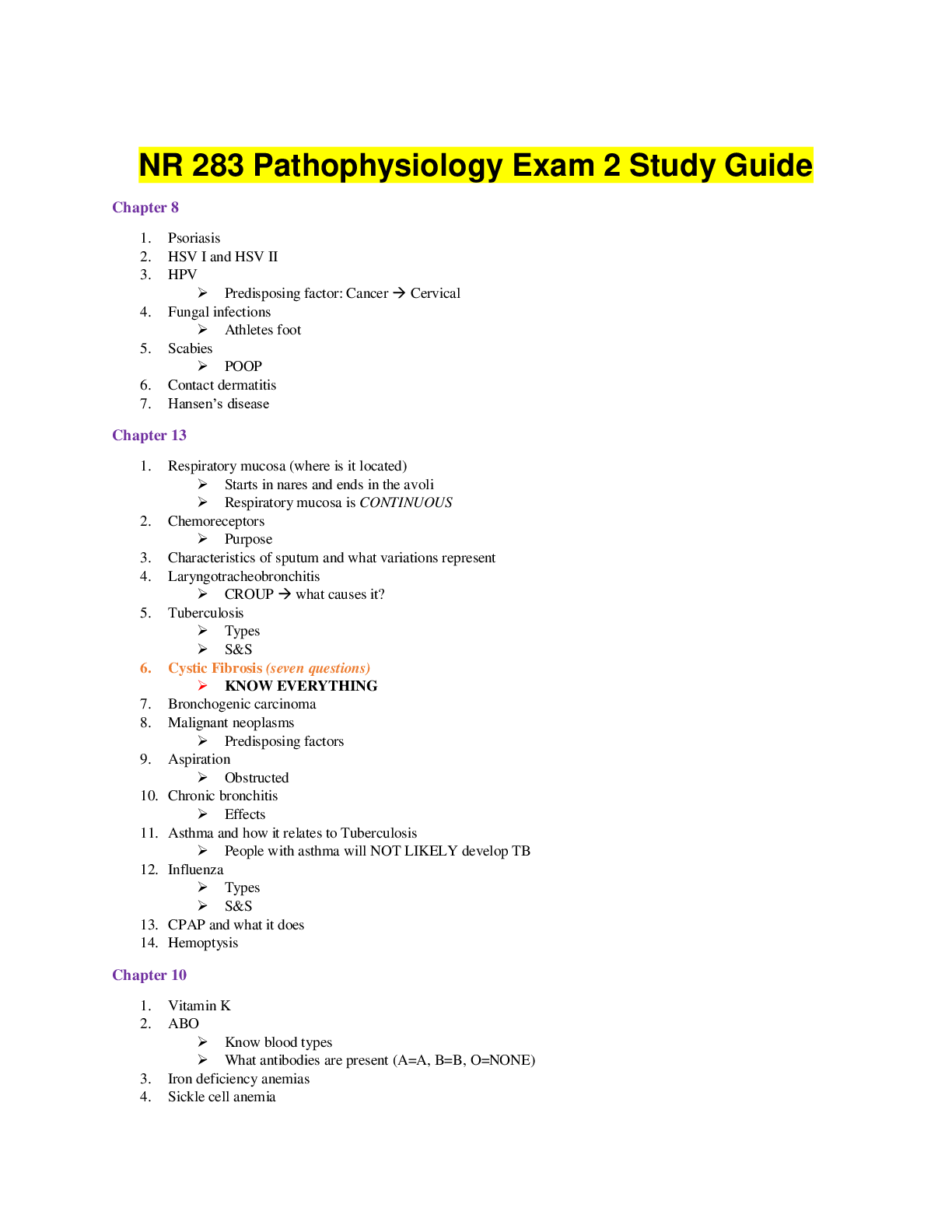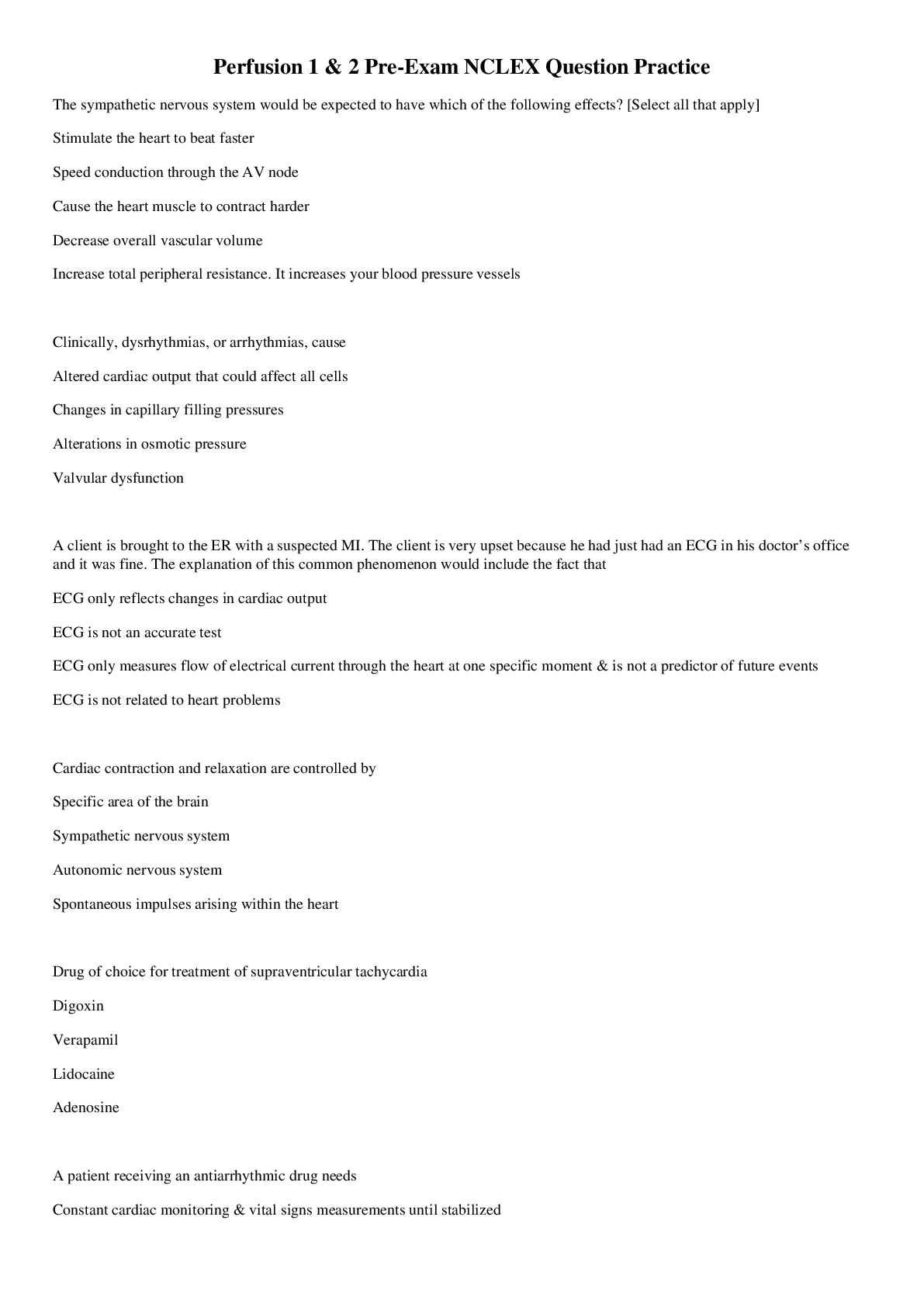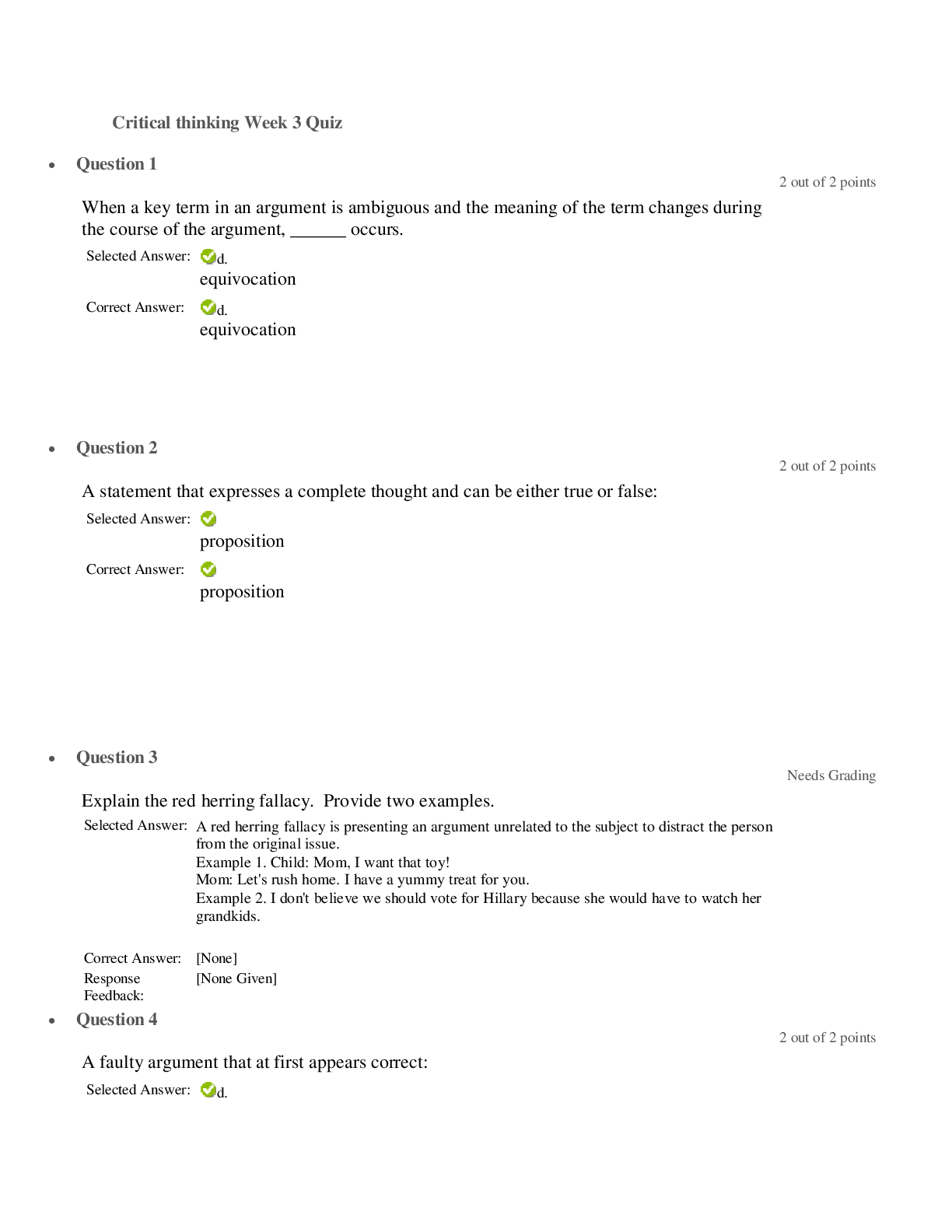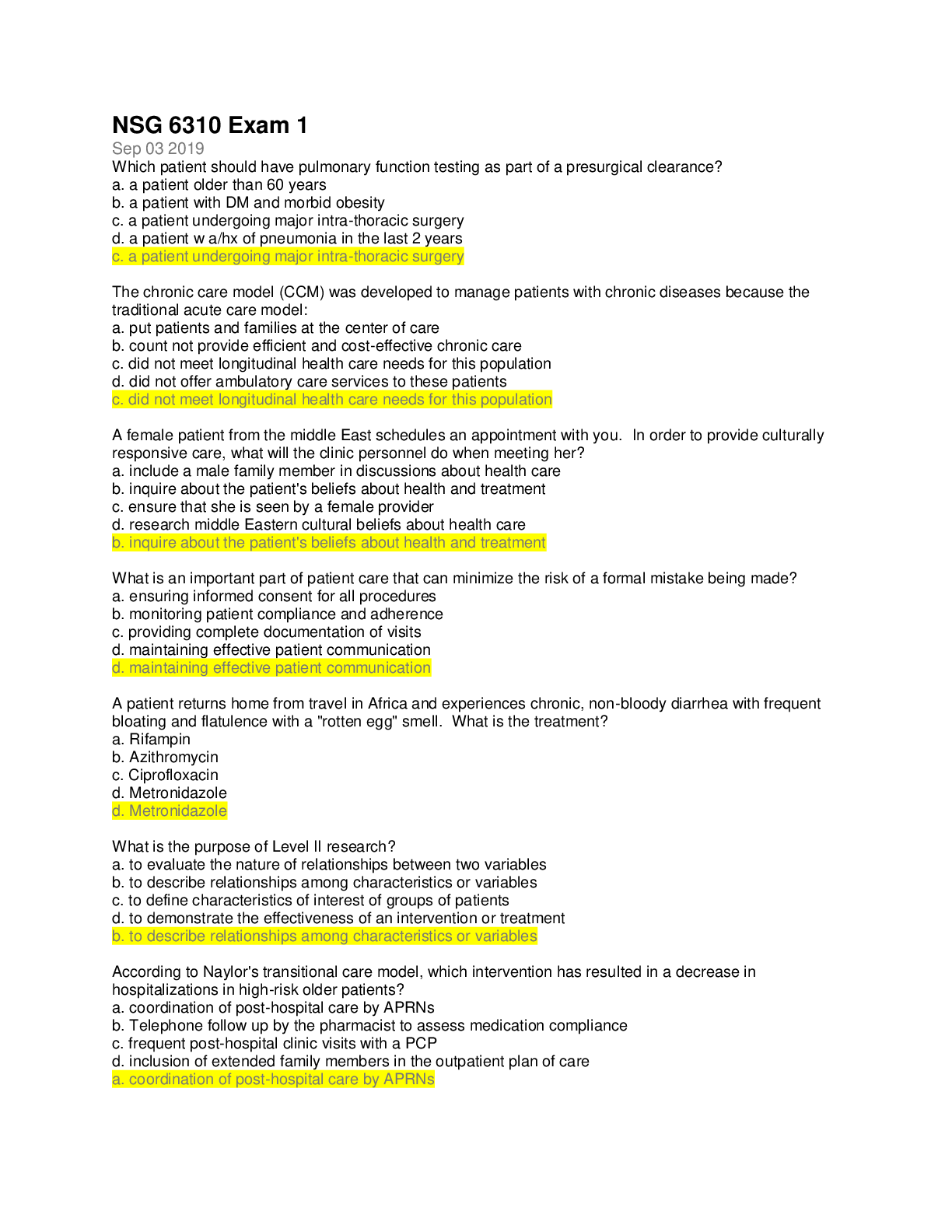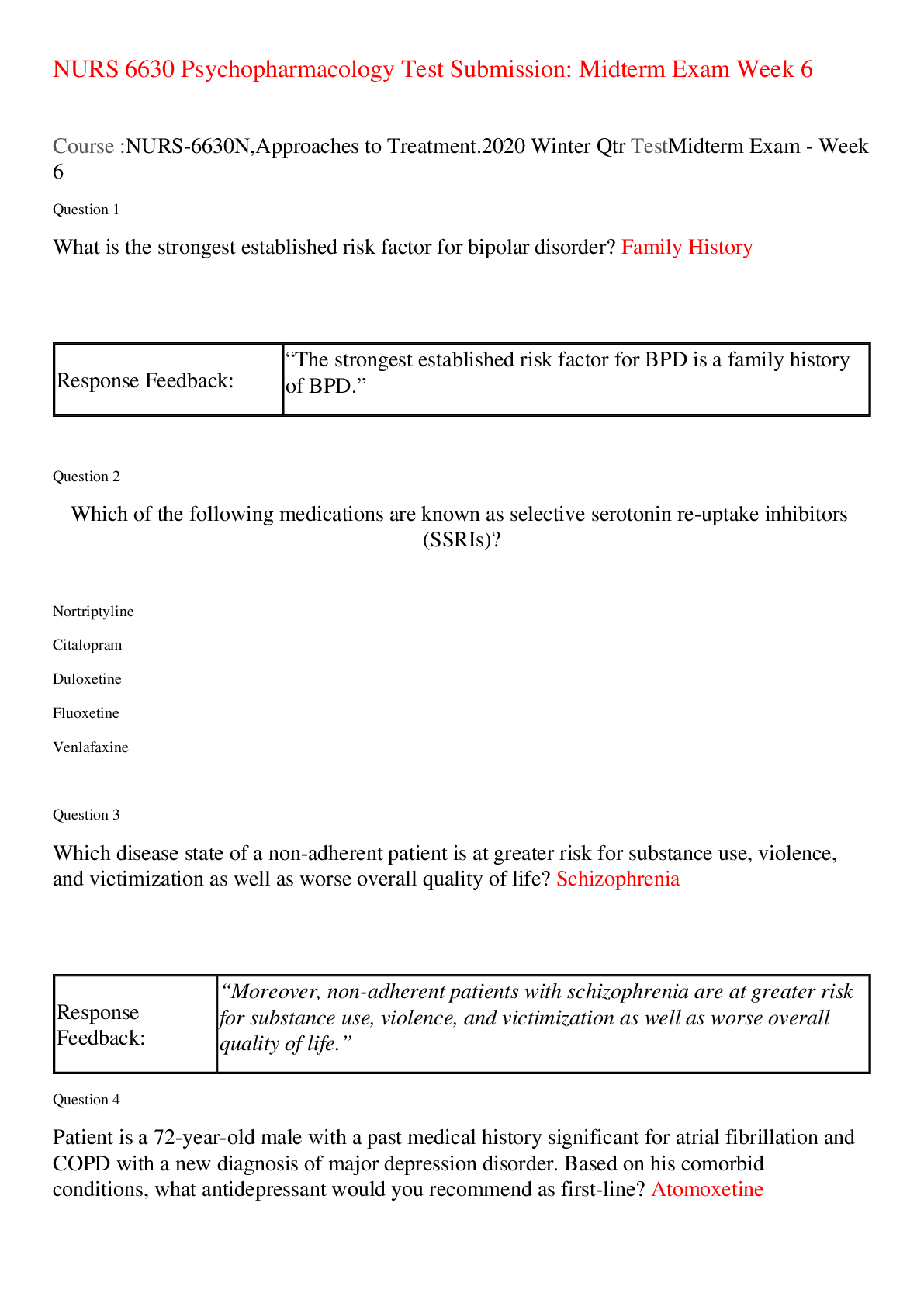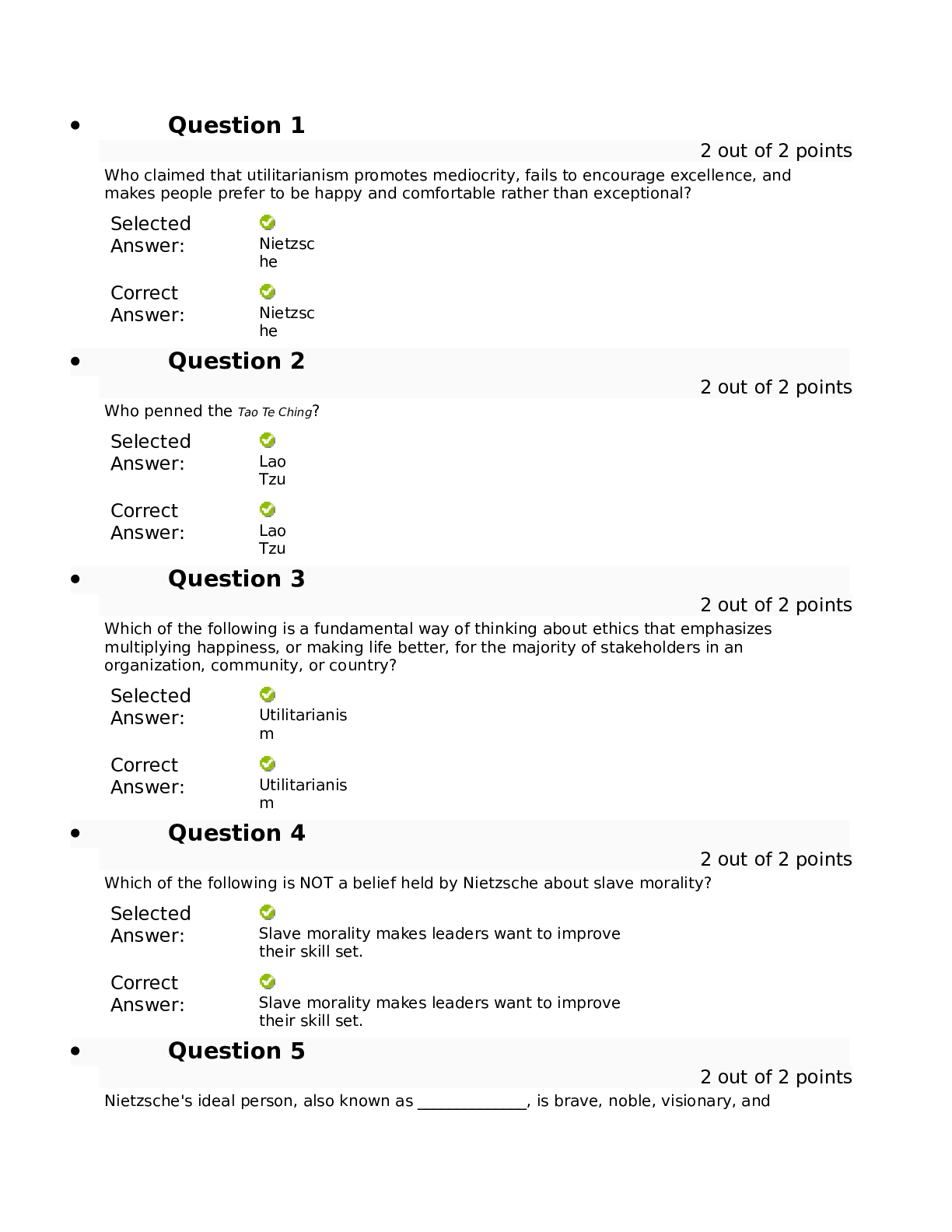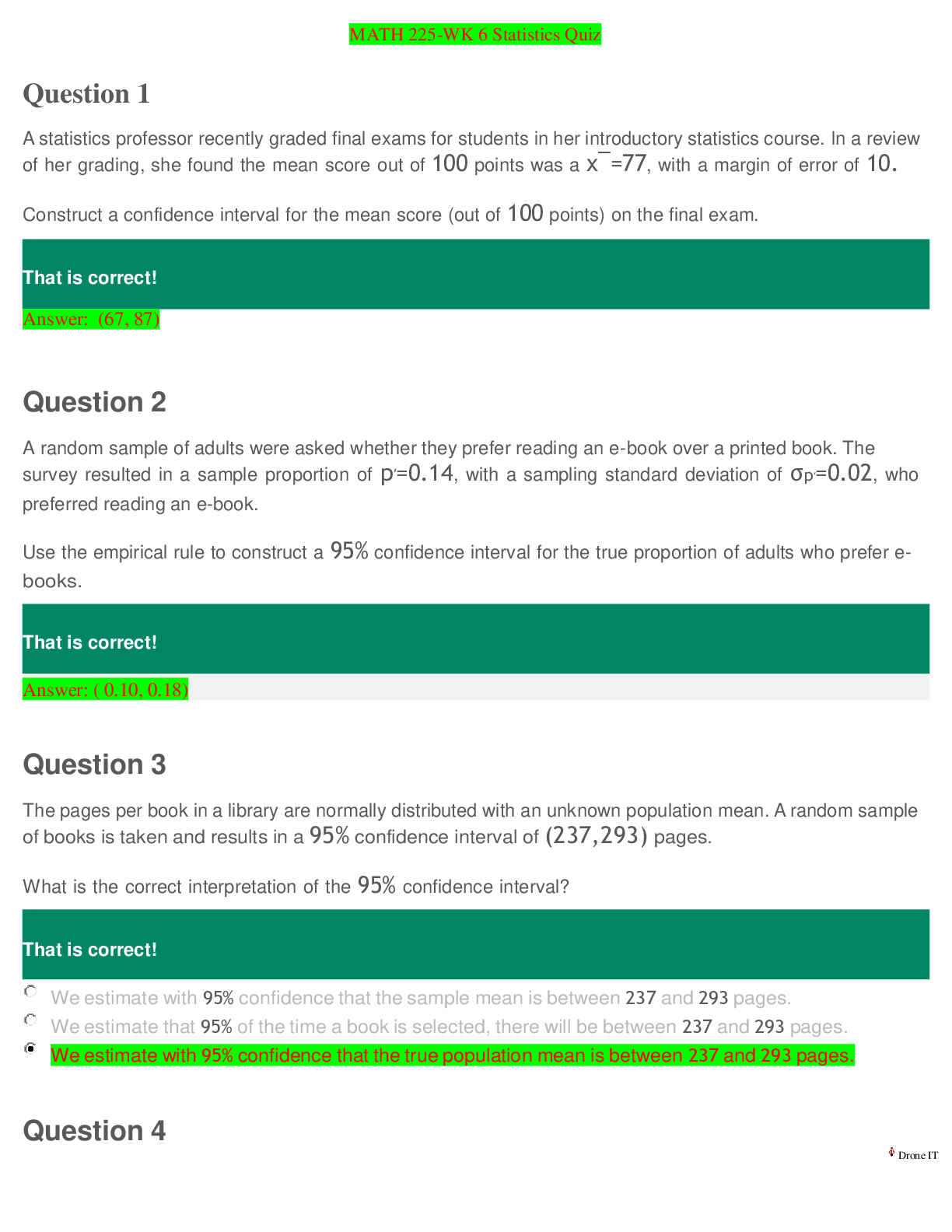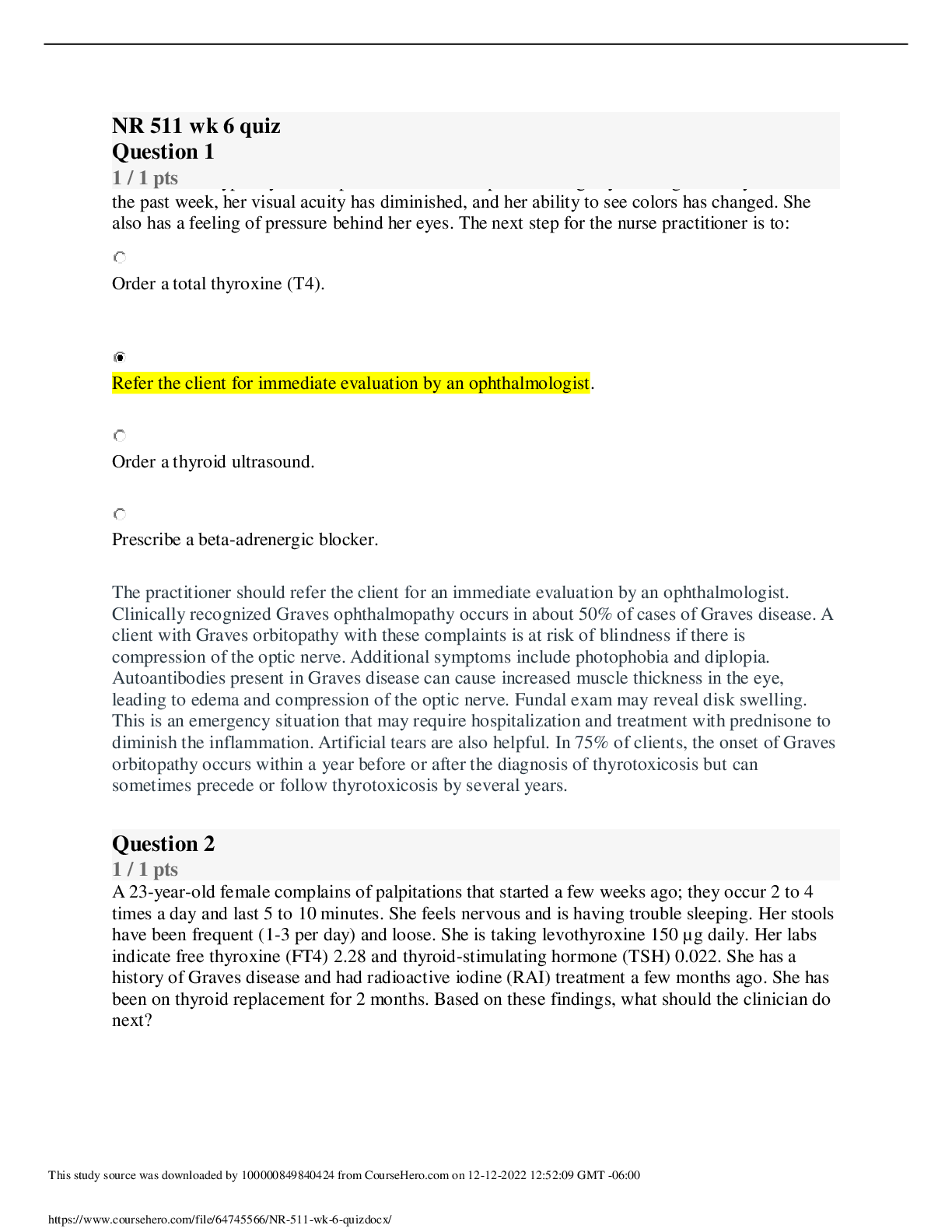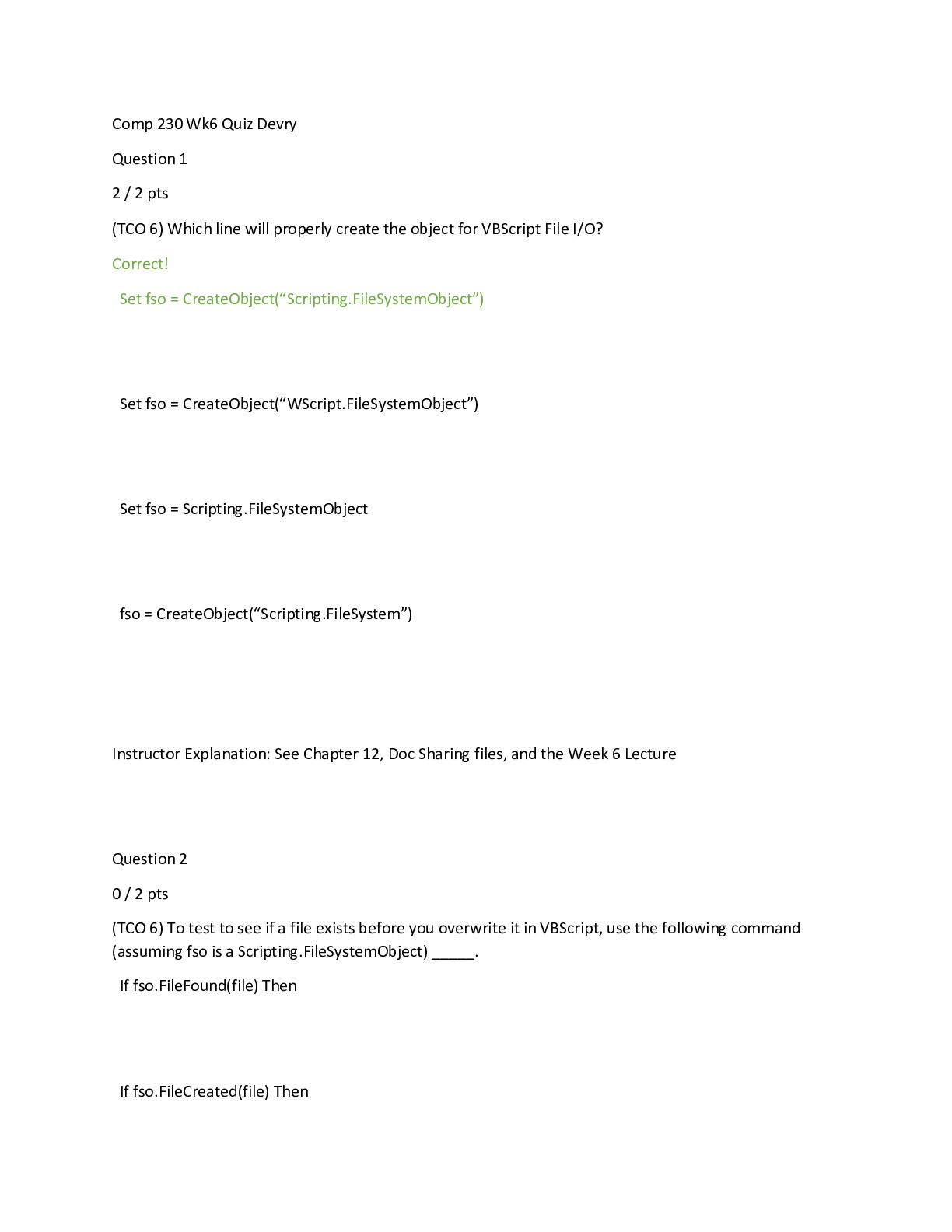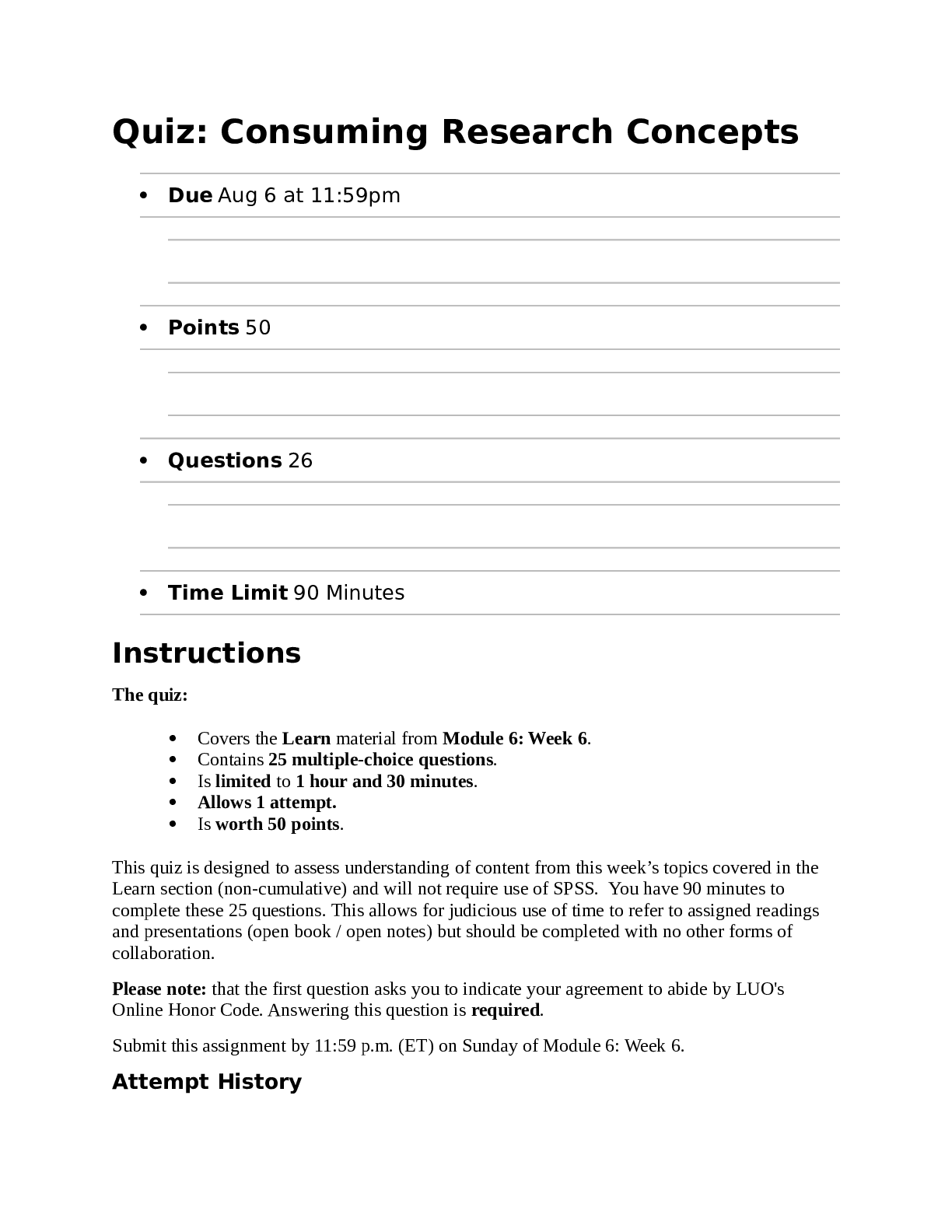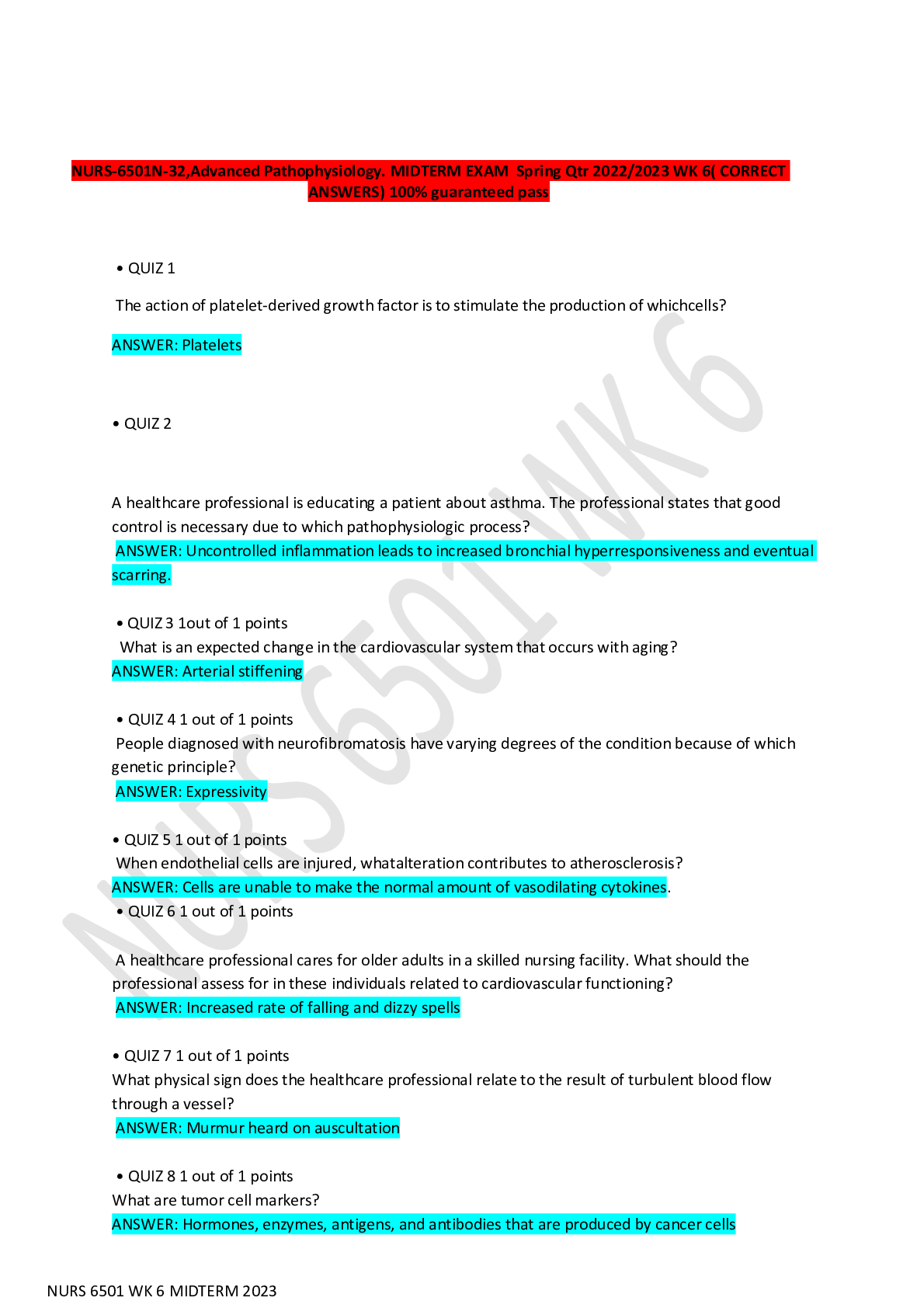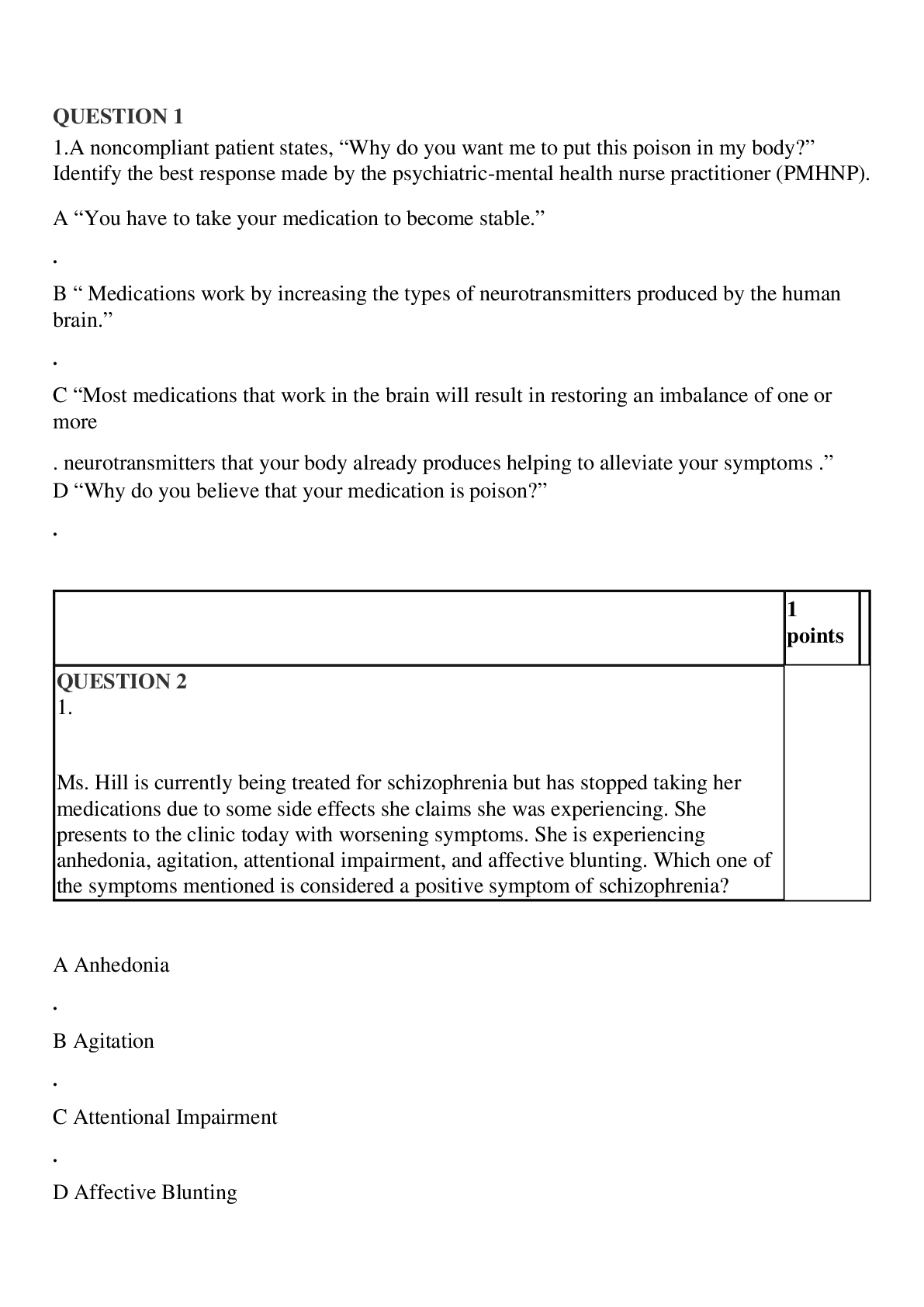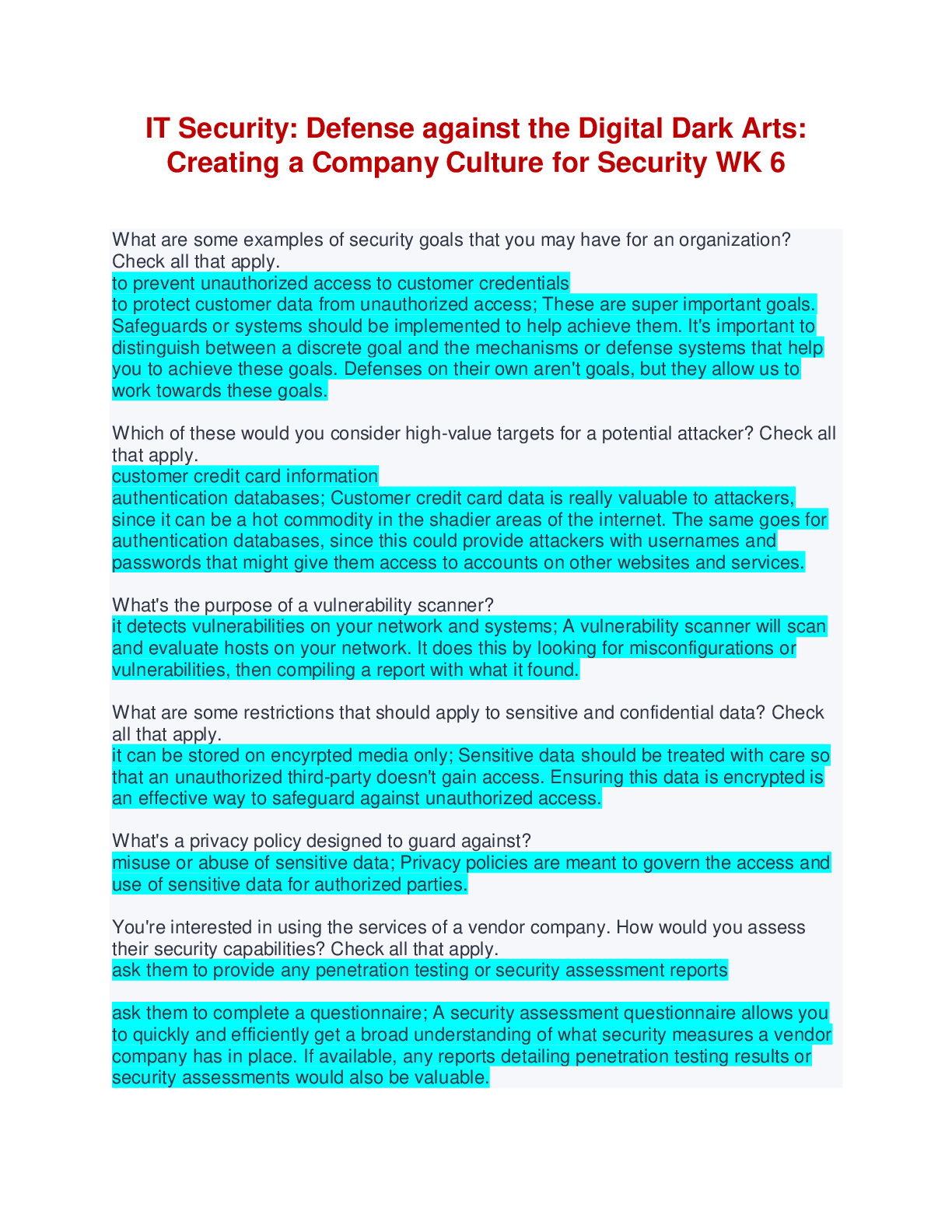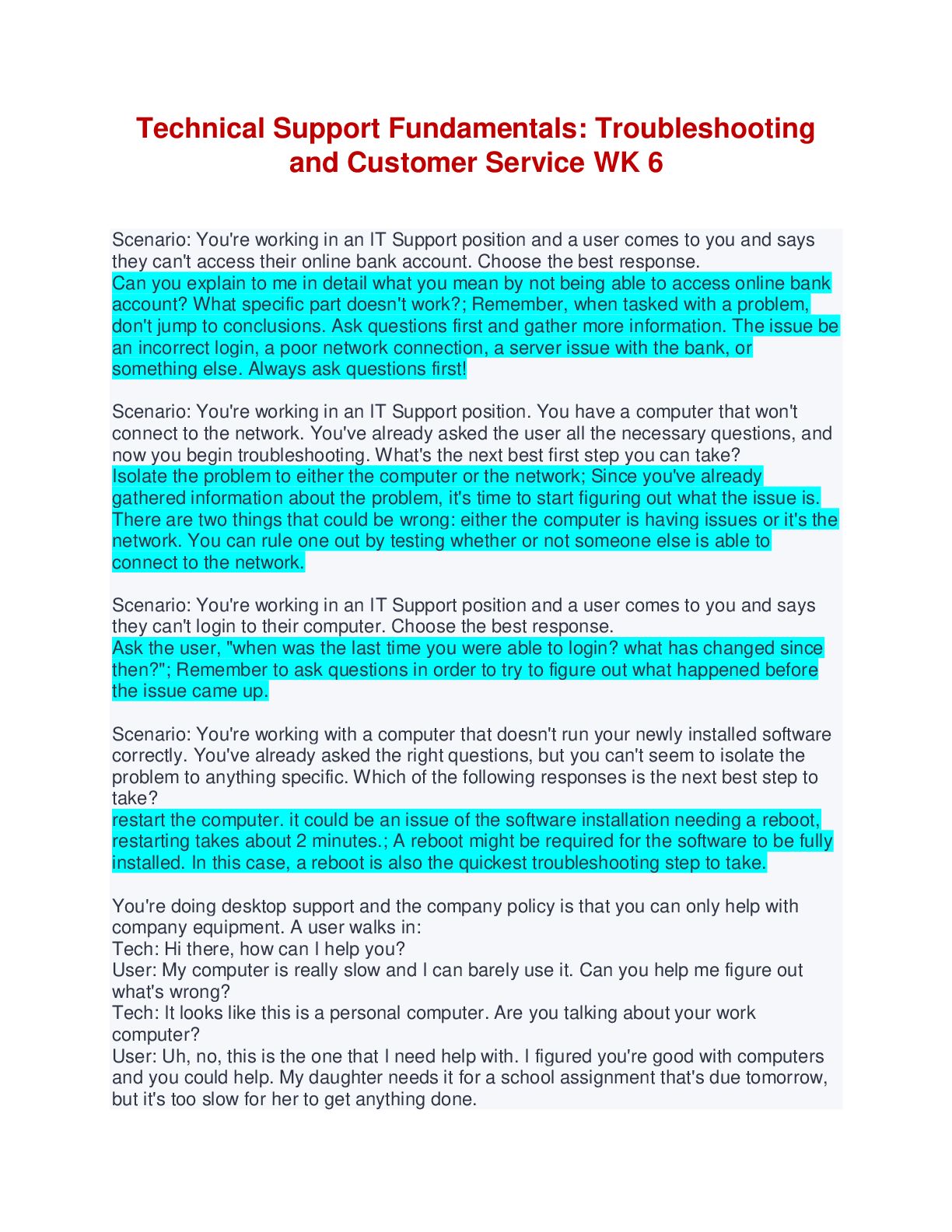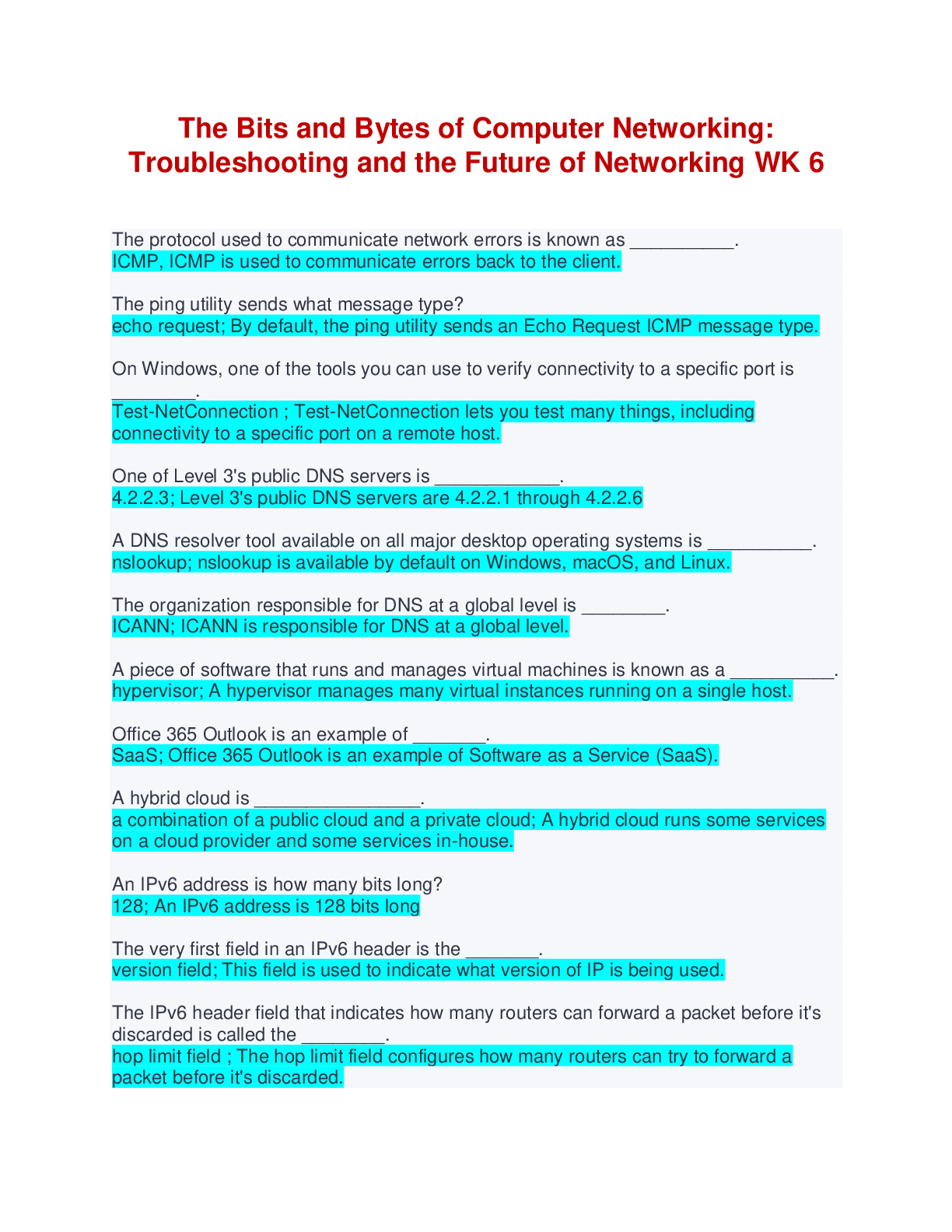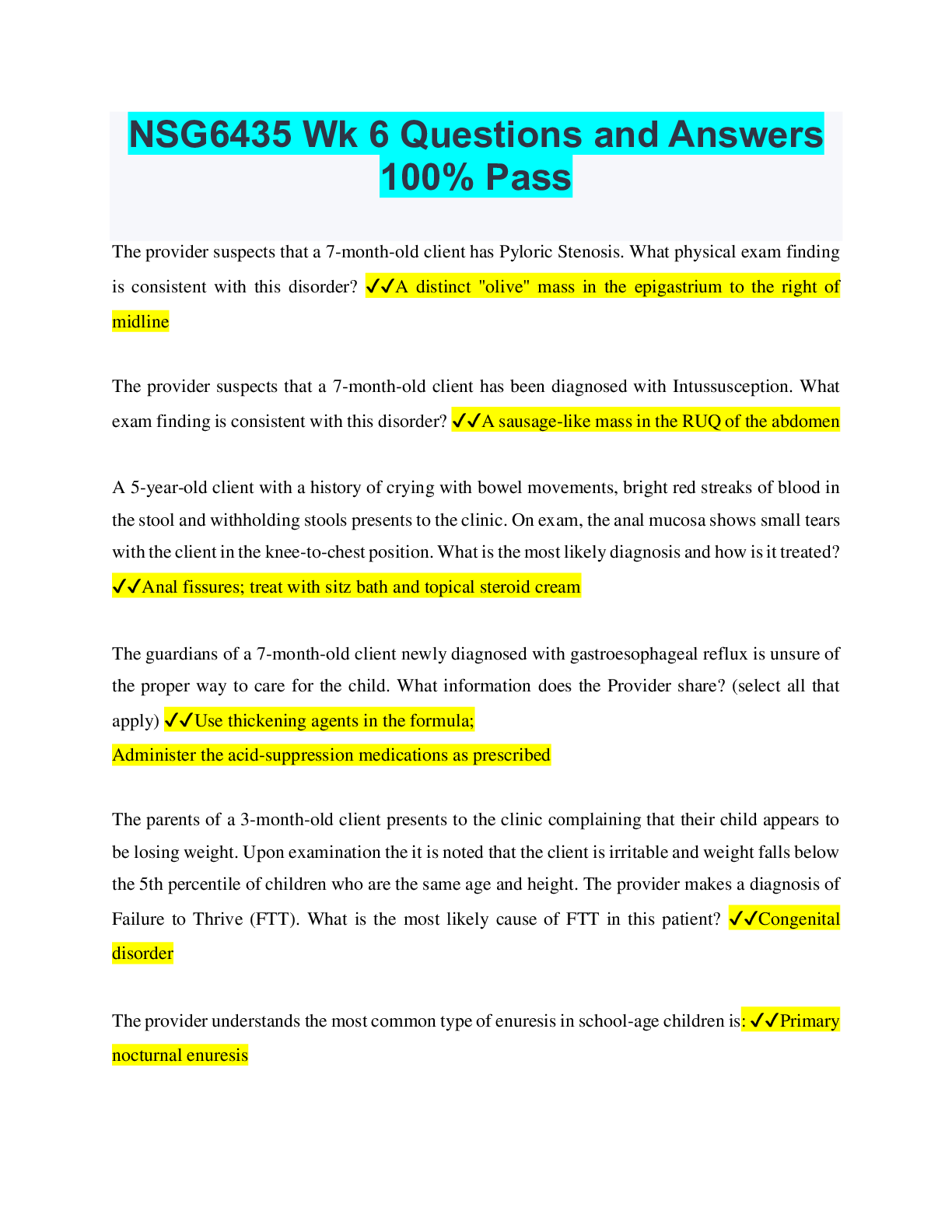Education > EXAM > Nursing 615 | Study Guid _ wk 6 quizlet. University of St. Louis {Score:101%} (All)
Nursing 615 | Study Guid _ wk 6 quizlet. University of St. Louis {Score:101%}
Document Content and Description Below
Henry presents to clinic with a significantly swollen, painful great toe and is diagnosed with gout. Of the following, which would be the best treatment for Henry? 1. High-dose colchicine 2. Low-dos... e colchicine 3. High-dose aspirin 4. Acetaminophen with codeine Patient education when prescribing colchicine includes: 1. Colchicine may be constipating. 2. Colchicine always causes some degree of diarrhea. 3. Mild muscle weakness is normal. 4. Moderate amounts of alcohol are safe with colchicine. Larry is taking allopurinol to prevent gout. Monitoring of a patient who is taking allopurinol includes: 1. Complete blood count 2. Blood glucose 3. C-reactive protein 4. BUN, creatinine, and creatinine clearance Phil is starting treatment with febuxostat (Uloric). Education of patients starting febuxostat includes: 1. Gout may worsen with therapy. 2. Febuxostat may cause severe diarrhea. 3. He should consume a high-calcium diet. 4. He will need frequent CBC monitoring. Sallie has been taking 10 mg per day of prednisone for the past 6 months. She should be assessed for: 1. Gout 2. Iron deficiency anemia 3. Osteoporosis 4. Renal dysfunction Patients whose total dose of prednisone will exceed 1 gram will most likely need a second prescription for: 1. Metformin, a biguanide to prevent diabetes 2. Omeprazole, a proton pump inhibitor to prevent peptic ulcer disease 3. Naproxen, an NSAID to treat joint pain 4. Furosemide, a diuretic to treat fluid retention Daniel has been on 60 mg of prednisone for 10 days to treat a severe asthma exacerbation. It is time to discontinue the prednisone. How is prednisone discontinued? 1. Patients with asthma are transitioned directly off the prednisone onto inhaled corticosteroids. 2. Prednisone can be abruptly discontinued with no adverse effects. 3. Develop a tapering schedule to slowly wean Daniel off the prednisone. 4. Substitute the prednisone with another anti-inflammatory such as ibuprofen. Patients with rheumatoid arthritis who are on chronic low-dose prednisone will need co-treatment with which medications to prevent further adverse effects? 1. A bisphosphonate 2. Calcium supplementation 3. Vitamin D 4. All of the above Patients who are on or who will be starting chronic corticosteroid therapy need monitoring of: 1. Serum glucose 2. Stool culture 3. Folate levels 4. Vitamin B12 Patients who are on chronic long-term corticosteroid therapy need education regarding: 1. Receiving all vaccinations, especially the live flu vaccine 2. Reporting black tarry stools or abdominal pain 3. Eating a high carbohydrate diet with plenty of fluids 4. Small amounts of alcohol are generally tolerated. 2. Reporting black tarry stools or abdominal pain All nonsteroidal anti-inflammatory drugs (NSAIDS) have an FDA Black Box Warning regarding: 1. Potential for causing life-threatening GI bleeds 2. Increased risk of developing systemic arthritis with prolonged use 3. Risk of life-threatening rashes, including Stevens-Johnson 4. Potential for transient changes in serum glucose Jamie has fractured his ankle and has received a prescription for acetaminophen and hydrocodone (Vicodin). Education when prescribing Vicodin includes: 1. It is okay to double the dose of Vicodin if the pain is severe. 2. Vicodin is not habit-forming. 3. He should not take any other acetaminophen-containing medications. 4. Vicodin may cause diarrhea; increase his fluid intake. When prescribing NSAIDS, a complete drug history should be conducted as NSAIDs interact with these drugs: 1. Omeprazole, a proton pump inhibitor 2. Combined oral contraceptives 3. Diphenhydramine, an antihistamine 4. Warfarin, an anticoagulant Josefina is a 2-year-old child with acute otitis media and an upper respiratory infection. Along with an antibiotic she receives a recommendation to treat the ear pain with ibuprofen. What education would her parent need regarding ibuprofen? 1. They can cut an adult ibuprofen tablet in half to give Josefina. 2. The ibuprofen dose can be doubled for severe pain. 3. Josefina needs to be well-hydrated while taking ibuprofen. 4. Ibuprofen is completely safe in children with no known adverse effects. Henry is 82 years old and takes two aspirin every morning to treat the arthritis pain in his back. He states the aspirin helps him to "get going" each day. Lately he has had some heartburn from the aspirin. After ruling out an acute GI bleed, what would be an appropriate course of treatment for Henry? 1. Add an H2 blocker such as ranitidine to his therapy. 2. Discontinue the aspirin and switch him to Vicodin for the pain. 3. Decrease the aspirin dose to one tablet daily. 4. Have Henry take an antacid 15 minutes before taking the aspirin each day. The trial period to determine effective anti-inflammatory activity when starting a patient on aspirin for rheumatoid arthritis is: 1. 48 hours 2. 4 to 6 days 3. 4 weeks 4. 2 months Patients prescribed aspirin therapy require education regarding the signs of aspirin toxicity. An early sign of aspirin toxicity is: 1. Black tarry stools 2. Vomiting 3. Tremors 4. Tinnitus Monitoring a patient on a high-dose aspirin level includes: 1. Salicylate level 2. Complete blood count 3. Urine pH 4. All of the above Patients who are on long-term aspirin therapy should have ______ annually. 1. Complete blood count 2. Salicylate level 3. Amylase 4. Urine analysis Paige has a history of chronic migraines and would benefit from preventative medication. Education regarding migraine preventive medication includes: 1. Medication is taken at the beginning of the headache to prevent it from getting worse. 2. Medication alone is the best preventative against migraines occurring. 3. Medication should not be used more than four times a month. 4. The goal of treatment is to reduce migraine occurrence by 50%. A first-line drug for abortive therapy in simple migraine is: 1. Sumatriptan (Imitrex) 2. Naproxen (Aleve) 3. Butorphanol nasal spray (Stadol NS) 4. Butalbital and acetaminophen (Fioricet) Vicky, age 56 years, comes to the clinic requesting a refill of her Fiorinal (aspirin and butalbital) that she takes for migraines. She has been taking this medication for over 2 years for migraines and states one dose usually works to abort her migraine. What is the best care for her? 1. Switch her to sumatriptan (Imitrex) to treat her migraines. 2. Assess how often she is using Fiorinal and refill her medication. 3. Switch her to a beta blocker such as propranolol to prevent her migraine. 4. Request she return to the original prescriber of Fiorinal as you do not prescribe butalbital for migraines. When prescribing ergotamine suppositories (Wigraine) to treat acute migraine, patient education would include: 1. Ergotamine will briefly make the migraine worse before the migraine resolves. 2. The patient may experience bradycardia and dizziness. 3. They may need premedication with an antinausea medication. 4. Ergotamine works best if the patient starts off with a full suppository to get the full effect. Migraines in pregnancy may be safely treated with: 1. Acetaminophen with codeine (Tylenol #3) 2. Sumatriptan (Imitrex) 3. Ergotamine tablets (Ergostat) 4. Dihydroergotamine (DHE) Xi, a 54-year-old female, has a history of migraines that do not respond well to OTC migraine medication. She is asking to try Maxalt (rizatriptan) because it works well for her friend. Appropriate decision making would be: 1. Prescribe the Maxalt, but only give her four tablets with no refills to monitor the use. 2. Prescribe Maxalt and arrange to have her observed in the clinic or urgent care with the first dose. 3. Explain that rizatriptan is not used for postmenopausal migraines and recommend Fiorinal (aspirin and butalbital). 4. Prescribe sumatriptan (Imitrex) with the explanation that it is the most effective triptan. Kelly is a 14-year-old patient who presents to the clinic with a classic migraine. She says she is having a headache two to three times a month. The initial plan would be: 1. Prescribe NSAIDs as abortive therapy and have her keep a headache diary to identify her triggers. 2. Prescribe zolmitriptan (Zomig) as abortive therapy and recommend relaxation therapy to reduce her stress. 3. Prescribe acetaminophen with codeine (Tylenol #3) for her to take at the first onset of her migraine. 4. Prescribe sumatriptan (Imitrex) nasal spray and arrange for her to receive the first dose in the clinic. Jayla is a 9-year-old patient who has been diagnosed with migraines for almost 2 years. She is missing up to a week of school each month. Her headache diary confirms she averages four or five migraines per month. Which of the following would be appropriate? 1. Prescribe amitriptyline (Elavil) daily, start at a low dose and increase dosage slowly every 2 weeks until it's effective in eliminating migraines. 2. Encourage her mother to give her Excedrin Migraine (aspirin, acetaminophen, and caffeine) at the first sign of a headache to abort the headache. 3. Prescribe propranolol (Inderal) to be taken daily for at least 3 months. 4. Explain that it is rare for a 9-year-old child to get migraines and she needs an MRI to rule out a brain tumor. Amber is a 24-year-old patient who has had migraines for 10 years. She reports a migraine on average of once a month. The migraines are effectively aborted with naratriptan (Amerge). When refilling Amber's naratriptan, education would include: 1. Naratriptan will interact with antidepressants, including selective serotonin reuptake inhibitors (SSRIs) and St John's wort, and she should inform any providers she sees that she has migraines. 2. Continue to monitor her headaches, if the migraine is consistently happening around her menses there is preventive therapy available. 3. Pregnancy is contraindicated when taking a triptan. 4. All of the above When prescribing for migraines, patient education includes: 1. Triptans are safe to be used as often as needed as long as the patient is healthy. 2. Use triptan before trying OTC meds such as acetaminophen or naproxen. 3. Stress reduction and regular sleep are integral to migraine treatment. 4. If migraines worsen they are to increase their medication. Juanita presents to the clinic with a complaint of headaches off and on for months. She reports they feel like someone is "squeezing" her head. She occasionally takes Tylenol for the pain, but usually just "toughs it out." Initial treatment for tension headache includes asking her to keep a headache diary and a prescription for: 1. Sumatriptan (Imitrex) 2. Naproxen (Aleve) 3. Ergotamine (Ergostat) 4. Tylenol with codeine (Tylenol #3) Nonpharmacologic therapy for tension headaches includes: 1. Biofeedback 2. Stress management 3. Massage therapy 4. All of the above James has been diagnosed with cluster headaches. Appropriate acute therapy would be: 1. Butalbital and aspirin (Fiorinal) 2. Meperidine IM (Demerol) 3. Oxygen 100% for 15 to 30 minutes 4. Indomethacin (Indocin) Preventative therapy for cluster headaches includes: 1. Massage or relaxation therapy 2. Ergotamine nightly before bed 3. Intranasal lidocaine four times a day during "clusters" of headaches 4. Propranolol (Inderal) daily When prescribing any headache therapy, appropriate use of medications needs to be discussed to prevent medication-overuse headaches. A clinical characteristic of medication-overuse headaches is that they: 1. Are increasing in frequency 2. Are increasing in intensity 3. Recur when medication wears off 4. Begin to "cluster" into a pattern Different areas of the brain are involved in specific aspects of pain. The reticular and limbic systems in the brain influence the: 1. Sensory aspects of pain 2. Discriminative aspects of pain 3. Motivational aspects of pain 4. Cognitive aspects of pain Patients need to be questioned about all pain sites because: 1. Patients tend to report the most severe or important in their perception. 2. Pain tolerance generally decreases with repeated exposure. 3. The reported pain site is usually the most important to treat. 4. Pain may be referred from a different site to the one reported. The chemicals that promote the spread of pain locally include: 1. Serotonin 2. Norepinephrine 3. Enkephalin 4. Neurokinin A Narcotics are exogenous opiates. They act by: 1. Inhibiting pain transmission in the spinal cord 2. Attaching to receptors in the afferent neuron to inhibit the release of substance P 3. Blocking neurotransmitters in the midbrain 4. Increasing beta-lipoprotein excretion from the pituitary gland Age is a factor in different responses to pain. Which of the following age-related statements about pain is NOT true? 1. Preterm and newborn infants do not yet have functional pain pathways. 2. Painful experiences and prolonged exposure to analgesic drugs during pregnancy may permanently alter neuronal organization in the child. 3. Increases in the pain threshold in older adults may be related to peripheral neuropathies and changes in skin thickness. 4. Decreases in pain tolerance are evident in older adults. Which of the following statements is true about acute pain? 1. Somatic pain comes from body surfaces and is only sharp and well-localized. 2. Visceral pain comes from the internal organs and is most responsive to acetaminophen and opiates. 3. Referred pain is present in a distant site for the pain source and is based on activation of the same spinal segment as the actual pain site. 4. Acute neuropathic pain is caused by lack of blood supply to the nerves in a given area. One of the main drug classes used to treat acute pain is NSAIDs. They are used because: 1. They have less risk for liver damage than acetaminophen. 2. Inflammation is a common cause of acute pain. 3. They have minimal GI irritation. 4. Regulation of blood flow to the kidney is not affected by these drugs. Opiates are used mainly to treat moderate to severe pain. Which of the following is NOT true about these drugs? 1. All opiates are scheduled drugs which require a DEA license to prescribe. 2. Opiates stimulate only mu receptors for the control of pain. 3. Most of the adverse effects of opiates are related to mu receptor stimulation. 4. Naloxone is an antagonist to opiates. If interventions to resolve the cause of pain (e.g., rest, ice, compression, and elevation) are insufficient, pain medications are given based on the severity of pain. Drugs are given in which order of use? 1. NSAIDs, opiates, corticosteroids 2. Low-dose opiates, salicylates, increased dose of opiates 3. Opiates, non-opiates, increased dose of non-opiate 4. Non-opiate, increased dose of non-opiate, opiate The goal of treatment of acute pain is: 1. Pain at a tolerable level where the patient may return to activities of daily living 2. Reduction of pain with a minimum of drug adverse effects 3. Reduction or elimination of pain with minimum adverse reactions 4. Adequate pain relief without constipation or nausea from the drugs Which of the following statements is true about age and pain? 1. Use of drugs that depend heavily on the renal system for excretion may require dosage adjustments in very young children. 2. Among the NSAIDs, indomethacin is the preferred drug because of lower adverse effects profiles than other NSAIDs. 3. Older adults who have dementia probably do not experience much pain due to loss of pain receptors in the brain. 4. Acetaminophen is especially useful in both children and adults because it has no effect on platelets and has fewer adverse effects than NSAIDs. Pain assessment to determine adequacy of pain management is important for all patients. This assessment is done to: 1. Determine if the diagnosis of source of pain is correct 2. Determine if the current regimen is adequate or different combinations of drugs and non-drug therapy are required 3. Determine if the patient is willing and able to be an active participant in his or her pain management 4. All of the above Pathological similarities and differences between acute pain and chronic pain include: 1. Both have decreased levels of endorphins. 2. Chronic pain has a predominance of C-neuron stimulation. 3. Acute pain is most commonly associated with irritation of peripheral nerves. 4. Acute pain is diffuse and hard to localize. A treatment plan for management of chronic pain should include: 1. Negotiation with the patient to set personal goals for pain management 2. Discussion of ways to improve sleep and stress 3. An exercise program to improve function and fitness 4. All of the above Chronic pain is a complex problem. Some specific strategies to deal with it include: 1. Telling the patient to "let pain be your guide" to using treatment therapies 2. Prescribing pain medication on a "PRN" basis to keep down the amount used 3. Scheduling return visits on a regular basis rather than waiting for poor pain control to drive the need for an appointment 4. All of the above Chemical dependency assessment is integral to the initial assessment of chronic pain. Which of the following raises a "red flag" about potential chemical dependency? 1. Use of more than one drug to treat the pain 2. Multiple times when prescriptions are lost with requests to refill 3. Preferences for treatments that include alternative medicines 4. Presence of a family member who has abused drugs The Pain Management Contract is appropriate for: 1. Patients with cancer who are taking morphine 2. Patients with chronic pain who will require long-term use of opiates 3. Patients who have a complex drug regimen 4. Patients who see multiple providers for pain control [Show More]
Last updated: 1 year ago
Preview 1 out of 8 pages
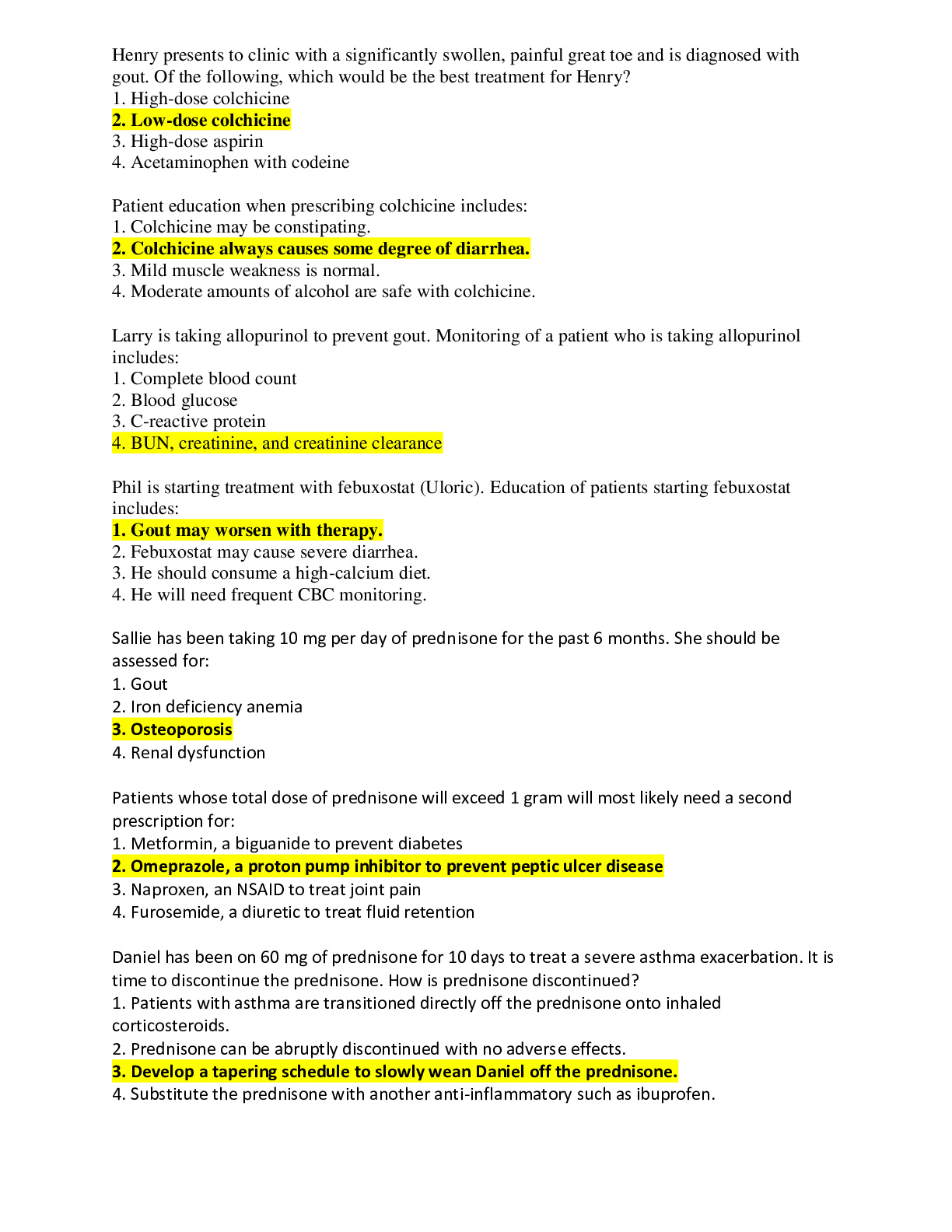
Reviews( 0 )
Document information
Connected school, study & course
About the document
Uploaded On
Sep 10, 2019
Number of pages
8
Written in
Additional information
This document has been written for:
Uploaded
Sep 10, 2019
Downloads
0
Views
99


